There are many things which have been lost in the halls of history. Those who have gone before us had ways of doing things that we can’t even imagine. In some cases, those ways were more ingenious than our own, as they found ways of doing things, without the technology we so much depend on.
Sadly, many of those methods are lost to us, especially in cases of groups of people with limited written language, who passed on lessons verbally, rather than through the written word. These people would have to know how to do a plethora of things on a daily basis, just in order to survive. Rather than sending their children to school to learn, parents would teach these skills on a daily basis.
The American Indians were one of these. They knew how to do countless things which are uncommon today. Some of these were recorded by the white man, in the early days of colonization and pioneering. But many more were never written down, which is our loss today.
Food was a major concern of the American Indians, especially the more nomadic tribes, like the Plains Indians. They were highly dependent on hunting and gathering, and as such, they let little go to waste. Indians used every part of an animal they killed; if not for food, than for some other purpose.
Preserving meat was a challenge in these times. We are all familiar with smoking and making jerky, but believe it or not, those weren’t the only means of preserving meat that the American Indians used. There may even have been many different ways that they did so, depending on the part of the country.
One such method used the inner bark from the slippery elm tree. This tree is fairly common throughout the eastern part of the United States and into the Midwest, as well as the eastern part of Canada. The tree can grow 50 to 60 feet tall and has a heavy grey-white bark. But it is the inner bark or “phloem” we are concerned with. This is the living part of the bark, through which food is passed through the tree. It is constantly being replaced, with the old phloem drying out and becoming part of the bark.
But it is the inner bark or “phloem” we are concerned with. This is the living part of the bark, through which food is passed through the tree. It is constantly being replaced, with the old phloem drying out and becoming part of the bark.
Related: 23 Medicinal Plants the Native Americans Used on a Daily Basis
Why Slippery Elm Bark?
The inner bark of the slippery elm tree is actually rather amazing, being used for medicinal purposes as far back as the 1st century. It is useful for treating wounds, sore throats, coughs, and a number of other health problems.
Technically, it is the mucilage and tannins in the inner bark which provide those benefits. It is the mucilage that is useful for treating problems with mucus membrane, such as sore throats. The tannis has strong astringent properties, making it useful for skin irritations.
It also has antibacterial properties, which are important for preserving meat. It has also been discovered that the inner bark provides anti-oxidants.
Unless you live somewhere where slippery elm trees grow, you’ll have to order your slippery elm bark online, as I did. It comes already shredded, making it extremely easy to use, either as an herbal remedy, or for the purpose we’re looking at it for right now – preserving meat.
Preserving Meat with Slippery Elm Bark
Since we’re looking at this as a method that the American Indians used, we want to use it as much as possible as they would, rather than how we might think of using it in modern times. They didn’t have electric blenders or food processors to cut up their bark and they didn’t have plastic bags to wrap it up in.
Unless you harvest fresh bark from a slippery elm, your bark is probably going to be dry, like the shredded bark that I bought. If you harvest the bark right off the tree, you’ll need to peel off the inner bark, which is fairly easy to do, while it is still moist. All you will need to do is scrape it out. But if you allow it to dry, you’ll need to use something like a wood carving gouge to remove it.
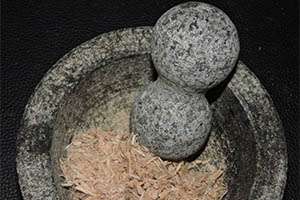 Dry bark will need to be shredded and ground, and it will need to be dry to grind it. The Indians would have used some sort of a stone grinding trough, or mortar and pestle to do this.
Dry bark will need to be shredded and ground, and it will need to be dry to grind it. The Indians would have used some sort of a stone grinding trough, or mortar and pestle to do this.
I don’t have one of those, but due to all the time I’ve spent in Mexico, I have a molcajete, which is a close approximation.
With the bark dry and shredded or ground, it’s time to make it slippery. Place a good handful of it in a bowl and add water. The bark will soak up the water and release mucilage, which is essentially a tree mucus. In case you were wondering, yes, it’s slimy.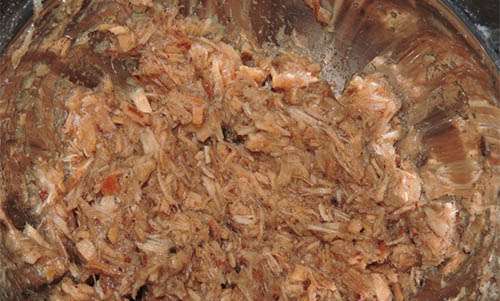 As an alternative to water, there were times when the Indians would use meat fat. But few of the animals they hunted for food had much fat on them, unlike our domesticated livestock.
As an alternative to water, there were times when the Indians would use meat fat. But few of the animals they hunted for food had much fat on them, unlike our domesticated livestock.
It’s impossible to apply the slimy bark to the meat alone and keep it there. Since they didn’t have plastic zipper bags to use back then, they would probably use a piece of soft leather, perhaps buckskin, to wrap the meat in, allowing them to package it and make it portable.
In order to use this as a preservative, we need to coat the meat with it. So, start by laying out a piece of leather or suede and spreading a thin layer of the now slippery bark onto it, covering enough area for the entire piece of meat. It’s hard to spread a layer that’s thinner than about 3/8”.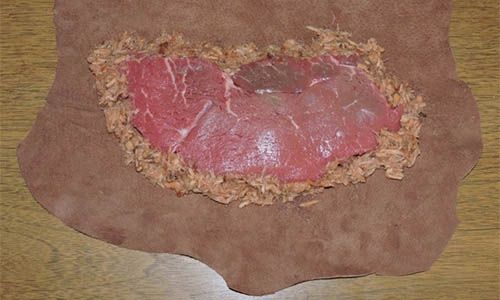 Either raw or partially smoked meat can be used with this method. The way smoking preserves meat is through a combination of soaking the meat in a salt brine, which will kill bacteria near the surface of the meat and then slow cooking the meat to a high enough internal temperature to kill bacteria inside the meat.
Either raw or partially smoked meat can be used with this method. The way smoking preserves meat is through a combination of soaking the meat in a salt brine, which will kill bacteria near the surface of the meat and then slow cooking the meat to a high enough internal temperature to kill bacteria inside the meat.
While that is happening, the collagen in the surface layers of the meat forms a skin, called “pellicle”.
Place the meat on top of the slippery elm bark and then add more wet bark on top of the meat, being sure to cover it all.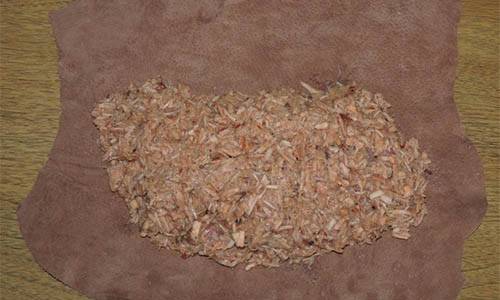 It is important to ensure that the entire surface of the meat is covered by the wet slippery elm bark, including the edges. Any gaps left in the bark would allow bacteria to get to the meat, causing it to begin decomposing.
It is important to ensure that the entire surface of the meat is covered by the wet slippery elm bark, including the edges. Any gaps left in the bark would allow bacteria to get to the meat, causing it to begin decomposing.
With the meat covered in this way, the leather can be wrapped around it, making a package. Start by folding the ends over and then roll the piece of leather, rolling the meat inside it. Tie it with a couple of leather thongs to keep the package from coming open.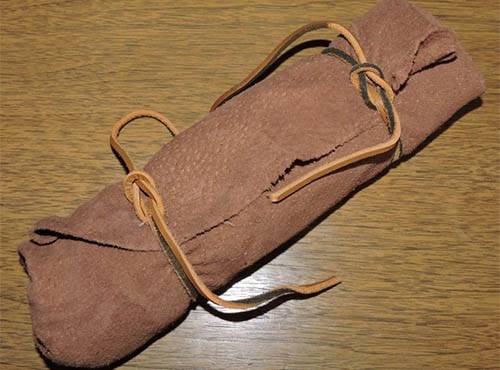 When it is time to eat the meat, the package is unwrapped and the slippery elm bark is wiped off or washed off. There is no problem if it can’t all be removed, as slippery elm bark can be ingested without any problem.
When it is time to eat the meat, the package is unwrapped and the slippery elm bark is wiped off or washed off. There is no problem if it can’t all be removed, as slippery elm bark can be ingested without any problem.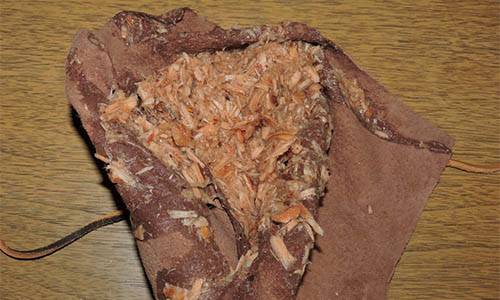 Some medicinal purposes for the bark require eating it, although nowadays that’s usually done as powder in capsules to make it more palatable.
Some medicinal purposes for the bark require eating it, although nowadays that’s usually done as powder in capsules to make it more palatable.
How Good Is the Preservation?
While this method does preserve meat, it’s not the kind of thing you’d want to use for meat that you’re putting in your food stockpile. This preserving method was something that Indians used when they were traveling or moving from place to place and needed to be able to keep their meat usable for up to a couple of weeks. After that, it may not be so usable.
Nevertheless, this is a useful method to know of, for the same reasons the Indians used it. If you are in a situation where you are living off the land and kill a deer, you’ll probably need to preserve the meat, at least on a short-term basis, until you eat it. This method would allow you to do that, as it can be used with large pieces of meat as well, as long as you have enough slippery elm bark and something to wrap the meat in.
You may also like:
 How to Build a Smokehouse In Your Backyard (with Pictures)
How to Build a Smokehouse In Your Backyard (with Pictures)
What To Do With All Your Frozen Food Once The Power Goes Out (Video)
How to Dehydrate Chicken for Survival (With Pictures)
An Ingenious Way to Catch Pigeons and Other Birds in Your Own Backyard

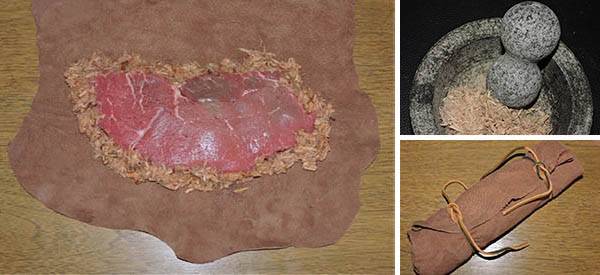













I am familiar with Slippery Elm, my wife takes it for Esophagitis,I also understand it was used a lot during the Civil war, with everything from rashes, stomach ailments to gun shot wounds.I am fascinated to come across this article for yet another application of this wonderful bark.While we don’t have Slippery Elm in Alaska, it would be interesting to know if our local natives have a preservation method akin to this.
Love your post Claude, they are invaluable!!
I am part Mi’Kmaq Indian, but I have never heard of this method. I do remember placing meat in a bucket and lowering it down into the well during hot summer months to preserve it, as it was cooler in the well and we had absolutely no electricity, running water, or indoor plumbing.
You mention using the mucilage for sore throats, and as well, I remember my father boiling hackmatack tree branches and having us breath in the vapors for our heavy colds and croup.
Interesting.
From childhood on I’ve used slippery elm to sooth m y throat or before singing. Its soothing and healing.
so how long does it preserve the meat? a day a week?
Is this info available in hard copy?
The article says up to two weeks.
Slippery elm bark has always been so readily available in natural food stores but this bit if knowledge dissemination was a delight. My first inclination was to anticipate the bark to be cinnamon bark. Kudos to the author. Another day passed away where my knowledge & wisdom expanded. Validating the fact that I still live.
An early lesson for a Texas country boy is to not put green slippery elm wood on the campfire, because of the smell of it burning we call it piss elm. Well dried, all elm wood is good heating wood, can be hard to split. American elm and slippery elm are both common here and hard to tell apart. The leaf test is to rub the underside of a leaf from end to end with your finger. The American elm leaf is sand papery in one direction only, from petiole to leaf tip. Slippery elm is sand papery in both directions.
Always amazing to me how pre-technological peoples figured out how all these things worked.
Spruce and pine are used in smoking meat (a very little!) because they kill bacteria. A small amount, or the meat is not eatable. Yew will kill you and cedar is not good, either.Sap from spruce and pines is very good for wounds. Burns like crazy, but it works. niio
I have mountain laurel growing in my backyard. I just discovered what it is. There is an app for iPhones that my daughter showed me that identifies plants and gives you a short paragraph on their uses and dangers. You take a picture of it and it searches for the plant and identifies it for you giving you color pictures of its flowers and leaves so that you can verify the identification.
According to the app mountain laurel is poisonous to man and beast. All parts of the plant are toxic, wood, roots and leaves. My chore this weekend will be to eradicate it from my yard.
I don’t know how I got it in my yard as apparently is is more native to the Appalachian foothills than the sere landscape of SoCal.
The app is really a time saver as it only takes a minute or two for it to identify the plant and saves pouring through a book or taking it to the nursery and having the nursery guy look through dozens of plants on line to get the right one and even then, sometimes he is guessing.
It’s two bad they can’t put the app on a thumb drive and sell it. I would buy it in a flash. The phone app is either free for a limited addition or $30 a year for the deluxe version.
Not schilling for the company, other than it is for the iPhone, I don’t even know who is selling it. The app is called “Picture This.”
There is a different mountain laurel that grows in the Texas hill country, it has glossy evergreen leaves and showy clusters of grape colored and grape scented flowers in spring. A legume, the fruit pods look like extra large peas, the seeds themselves a deep red color when ripe and full of strychnine. They were a powerful religious intoxicant for various groups of
Indians, the seed was crushed while still pink and soft, mixed with a fermented beverage and ritually consumed. The drink was called ‘Big Drunk’, also the Cherokee name for Sam Houston. It went out of fashion when Quanah Parker popularized the use of the much safer Peyote across Texas and Oklahoma. The Texas Mountain Laurel is Sophora secundiflora.
When I was a pup we had to identify plants by leaf structure, if we were lucky, or by looking at the anatomy of the flower with a 10x hand lens, aided by printed Keys and botanical drawings. Digital photography and the internet have made learning about plants so easy, and there are so many great sites like the one you mentioned.
The story of Quanah Parker is history worth reading.
Mike: mescal bush? We have them. Very bad news. Sophora! Man, I never get the spelling right, means a sleep aid.Mescal is about the last thing I’d want to try. A liberal stoner with a sledgehammer would be safer.
Parker never did get over how his mother was treated when she was forced to go back.
Mescal’s native range is Texas and a small part of New Mexico, wonder if Indians (or liberal stoners) planted it in Arizona to have access to the seeds? Like Morning Glory, Argyreia, Datura, and Peyote Mescal has varying levels of strychnine and related compounds that can make you extremely ill, experimenting with them is almost as dangerous as inexperienced foraging in the Umbellifers
When Quanah’s Band was finally led to the Reservation by Bad Hand Mackenzie he had every right to be angry and bitter. Instead he started a ranch in Oklahoma, married 7 wives, and was one of the founders of The Native American Church which preserved, in mixed format, a great deal of the spiritual culture of Plains and Western tribes, including the Peyote rituals. It just moves me greatly that there are 10,000 years of culture almost completely lost but we get all these bits of it in articles about preserving meat with elm bark and in the hints we’re always getting in stories about Red’s extended family.
Mike: Like the saying goes, witches are everywhere. The AIC is stilled called that in most places. Use drugs, datura, coke, anything to cheat in spiritual things, you might wind up with a woman’s ax in the chest. It happens at least once a year. Peyote is a witch’s drug. I gave all that up a lot of years ago. Mescal bean is illegal in states outside it’s native range.
Not just my extended family, chico. You’s too 🙂 niio
Had a memorable conversation about Peyote with my Dad 50 years ago, he said it was just the common foolishness of young people that they think psychedelic drugs lead them to special power and knowledge, that when he was a kid they thought the same about liquor, that in the end it’s all just intoxication,leading nowhere. He was right, of course.
The Yoruba rituals were practiced by most of the African tribes who were sold into American slavery. The white masters prohibited the practice of that religion and converted the slaves to Christianity, eventually the old religion came to be considered witchcraft and the work of Satan.
Mike: Agreed, but liberals are always willing to shriek it da debil (God bless the waterboy’s mama 🙂 But, anything that demands human sacrifice, use of drugs rather than seeking the spirit world thru fasting and dance, a few other things is witchcraft.
We protect owlmen and shon people as long as they police themselves. Down in C. America, the vampire worshipers are accepted. they only use rapists, liars, and murderers on the altar stones. Then, the old god judges his own, the criminals. Different strokes for different folks.
Yoruba also practiced root works, and that is witchcraft. Most who came to Christ did so because most black Africans can trace ancestry back to the lost tribes of Israel. Lemba are Levites and recognized by Israel as such, Ethiopians, Judah and Dan. Zulu, Judah. Genetic testing showed it true. niio
I read a biography of him some time ago.
chuck, every area hath its demons. some laurel are usable, like bay laurel. Most are a sophuric, but only under a doctor’s care. If its cherry laurel, it’s completely toxic, They need it hot and dry. Me, I’d get rid of it. we have a mescal bush out back, but no little kids around so it can stay and poison rodents. the laurel family includes oleander, which has only one use, to stuff in rat holes to kill them. niio
https://apps.apple.com/us/app/picturethis-plant-identifier/id1252497129
Red: There is a typo in your post that I can’t decipher. What did you mean by “sophuric” ? Did you mean sulfuric as in sulfuric acid?
chuck: Soporific, to induce a deep sleep. My bad. We got some ran and maybe I was a little giddy 🙂 If you have trouble sleeping, some times burning a bay laurel leaf in the house will help. Same family. Donno if I would want to touch any other sophora, tho. Yours is almost as bad as mescal bean. niio
That is a really good tip especially to those new to the blogosphere.
Simple but very accurate information… Thanks for sharing this one.
A must read post!